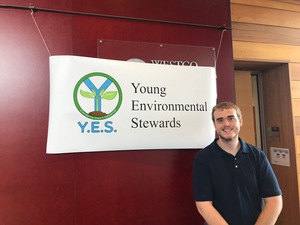Student's capstone project symbolizes goal of Essential Studies Program

CHADRON – A final project designed by Chadron State College senior Quentin Wagner reflects the principles of the college’s Essential Studies Program and the transformation faculty hope to see in a student between a First Year Inquiry course and a Capstone course.
Wagner, of Ainsworth, Nebraska, created a Young Environmental Stewards (YES) competition for Outside: Yourself in the World (CAP 469E) taught by Dr. Matt Evertson. Wagner researched and targeted a specific area of concern, nature deficit disorder, and explored what age group to target for the most impact and developed creative programming to address the problem with middle school students, according to Evertson.
Wagner said the program, which he developed with help from staff of the local Natural Resource Conservation Service (NRCS) and the Upper Niobrara White Natural Resource District (UNWNRD) is intended to help children learn how to conserve the environment.
Evertson said Wagner’s project illustrated a great deal of growth and full integration of the skills, modes of inquiry and personal and social responsibility that faculty hope students gain through Essential Studies.
Among the things Wagner, who has been hired by the NRCS and is completing training in Lincoln, learned throughout the process was the importance of being flexible and resourceful. The original mock competition he planned between Gordon-Rushville seventh and eighth grade students was canceled due to snow during CSC’s Annual Scholastic Day Contest April 6. He worked with Evertson, other CSC faculty, and Gordon-Rushville school officials to reschedule the mock competition for April 30.
The competition featured “Bake a Soil Profile,” in which students placed layers of household cooking ingredients into large clear glass containers to represent different soil horizons and textures. The ingredients were representative of various soil textures and materials. For example, graham crackers and rice cereal represented bedrock and gravel, and brown sugar represented loam, a mixture of sand silt and clay particles.
“Although these were the intended purposes of the ingredients, both teams went above and beyond and used the ingredients in ways I didn’t even think of. All around, they created some very innovative, logical, and aesthetic soil profiles for the competition,” Wagner said. “Gummy worms and animal crackers were thrown in for fun to add some critters to the landscapes.”
During the competition, members of one team asked if they could add water to their profile for a more realistic color and consistency even though water was not provided. The judges agreed. Evertson said this spontaneous learning moment was significant.
“We who witnessed this were all impressed by the thinking outside the box approach from these young minds working collaboratively on their challenge. Right before us was a demonstration of the essence of inquiry-guided learning. It was a small thing, but captured the spirit of what Essential Studies is all about at CSC,” Evertson said.
The student teams had 15 minutes to create their soil profiles and were then required to make a 10-minute presentation to a panel of judges including Professor Emeritus of Agriculture Dr. Jim O’Rourke, Assistant Professor Dr. Aaron Field, and Nevin Price with UNWNRD. In the presentations, each team explained how the soil in their profile was formed, what caused the different colors in the horizon, how wildlife and livestock would utilize vegetation produced on the top soil and how to best control erosion.
“Quentin staged a really terrific event. He did almost all of the preparations and planning on his own. This is truly his project. He conceived it, executed it, wrote eloquently about it, publicized it—and in the process he has created an program that could potentially blossom into an established framework for future events and activities, all under the umbrella of his inspired idea,” Evertson said. “He even contracted the creation of a logo for the YES program.”
Evertson said he cited Wagner as an example of a student who has learned from the key features of the Essential Studies Program during a recent program with incoming CSC students and their parents.
As a student in Evertson’s spring 2015 Learning to Serve (FYI 169AB) course, Wagner embraced the concept of inquiry-guided learning by spending eight days initiating a service project with Kenwood Intermediate students affiliated with a national Science Technology Engineering and Math program called Destination Imagination, according to Evertson.
“Quentin’s trajectory through the Essential Studies Program is exactly what we hoped to see when it was implemented. He experimented with community outreach and service when he was a freshman. By the time he was a senior, he was able to apply all the things he had learned in his major, as well as in his Essential Studies coursework, to put together an even more complex, mature and highly-evolved project for our Capstone,” Evertson said. “This is what we always hope a college experience can engender—hands-on, real-world, experimental play and exploration of ideas and problems and solutions. These are the sort of experiences that can translate into CSC graduates who are ready to hit the ground running in their careers and become transformative and engaged citizens in their future communities.”
Category: Campus News, Essential Studies



